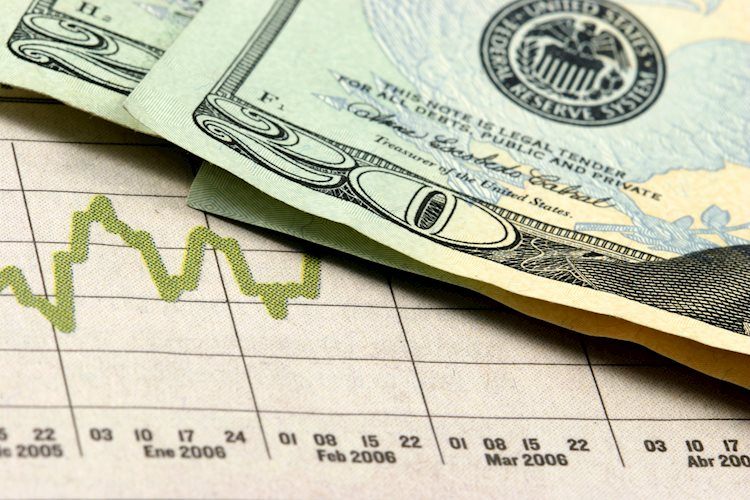- The DXY index declined to 104.10, its lowest level since early September and below the 100-day SMA.
- The headline and core CPI from October came in lower than expected.
- Investors are expecting rate cuts sooner, betting on no more hikes by the Fed in 2023.
The US Dollar (USD) experienced a substantial downward movement in Tuesday’s session, and the DXY index, which measures the value of the US Dollar versus a basket of global currencies, tanked to 104.25 driven by a lower-than-expected CPI and dovish bets on the Fed. Focus now shifts to the Producer Price Index (PPI) and Retail Sales figures from October on Wednesday.
As the United States economy recently printed lower than expected job creation and inflation figures, markets are taking off the table a rate hike at the next Federal Reserve (Fed) meeting in December. In addition, investors are seeing rate cuts sooner, in May 2024. This has made US Treasury yields decline, thus giving the market a reason to lose interest in the US Dollar.
Daily Digest Market Movers: US Dollar weakens as soft CPI fuels dovish bets on the Fed
- The US Dollar Index dived to 104.25, down more than 1% and standing near lows not seen since September, after the report of lower inflation figures.
- The US Bureau of Labor Statistics reported that the Core Consumer Price Index (CPI) from October missed the consensus. It came in at 4% YoY vs the expected 4.1% and decelerated from its previous figure of 4.1%.
- The headline figure came in at 3.2%YoY, below the consensus of 3.3% and in relation to its last reading of 3.7%.
- US Treasury yields fell vertically with the 2-year rate declining to 4.86%, while the 5 and 10-year rates declined to 4.45% and 4.46%, respectively..
- According to the CME FedWatch Tool, the odds of a 25-basis-point hike in December are extremely low, below 10%. In addition, markets are now pricing in rate cuts in May 2024.
- On Wednesday, the US will report Retail Sales from October, which are expected to have contracted by 0.3%, while the Producer Price Index (PPI) from the same month is expected to decelerate to 1.9% YoY.
Technical Analysis: US Dollar bears gain ground and challenges the 100-day SMA
Based on the daily chart, the DXY Index has a bearish bias as indicators are flashing signs of bears seizing control. The Relative Strength Index (RSI) is trending below its midline, while the Moving Average Convergence Divergence (MACD) histogram displays rising red bars.
Despite bears gaining ground and pushing the pair below the 20 and 100-day Simple Moving Average (SMA) in the short term, the DXY is still above the 200-day SMA. This suggests that bulls are in control in the broader context.
Support levels: 104.10, 103.60 (200-day SMA), 103.30.
Resistance levels: 104.15 (100-day SMA), 104.50, 105.00.
Inflation FAQs
Inflation measures the rise in the price of a representative basket of goods and services. Headline inflation is usually expressed as a percentage change on a month-on-month (MoM) and year-on-year (YoY) basis. Core inflation excludes more volatile elements such as food and fuel which can fluctuate because of geopolitical and seasonal factors. Core inflation is the figure economists focus on and is the level targeted by central banks, which are mandated to keep inflation at a manageable level, usually around 2%.
The Consumer Price Index (CPI) measures the change in prices of a basket of goods and services over a period of time. It is usually expressed as a percentage change on a month-on-month (MoM) and year-on-year (YoY) basis. Core CPI is the figure targeted by central banks as it excludes volatile food and fuel inputs. When Core CPI rises above 2% it usually results in higher interest rates and vice versa when it falls below 2%. Since higher interest rates are positive for a currency, higher inflation usually results in a stronger currency. The opposite is true when inflation falls.
Although it may seem counter-intuitive, high inflation in a country pushes up the value of its currency and vice versa for lower inflation. This is because the central bank will normally raise interest rates to combat the higher inflation, which attract more global capital inflows from investors looking for a lucrative place to park their money.
Formerly, Gold was the asset investors turned to in times of high inflation because it preserved its value, and whilst investors will often still buy Gold for its safe-haven properties in times of extreme market turmoil, this is not the case most of the time. This is because when inflation is high, central banks will put up interest rates to combat it.
Higher interest rates are negative for Gold because they increase the opportunity-cost of holding Gold vis-a-vis an interest-bearing asset or placing the money in a cash deposit account. On the flipside, lower inflation tends to be positive for Gold as it brings interest rates down, making the bright metal a more viable investment alternative.
Read the full article here

